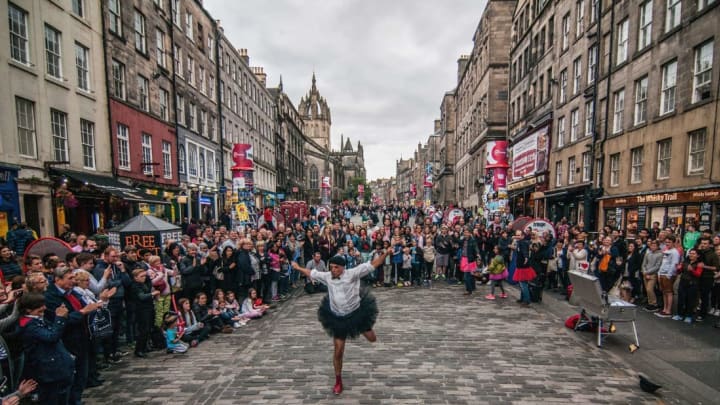For three weeks each August, the streets and squares of Scotland's capital buzz with activity as people pour into the city for the Edinburgh Fringe Festival. Held adjacent to the more formal Edinburgh International Festival, it hosts a dazzling range of theater, music, dance, comedy, and more. Thousands of performances are spread across hundreds of different stages throughout the city. Here are eight notable facts about the Edinburgh Fringe Festival, which kicks off in a hybrid in-person and virtual form on August 6, 2021.
1. The Edinburgh Fringe Festival began in 1947 as a platform for those who weren't invited to the main festival.
After the Second World War, people on the Edinburgh and British Councils wanted to create an international festival of the arts to reconnect people from different countries. Participation was by invitation only, which left a number of theater groups out in the cold. Eight of them decided to come to Edinburgh and perform their shows anyway. The initial participants didn’t use the term fringe (they described their groups as the “Festival Adjuncts”); the expression was used in an article by the dramatist Robert Kemp in 1948 when previewing the upcoming second edition of the main festival. It continued to be used informally for a number of years before gradually becoming the event's official title.
2. Millions of people attend the Edinburgh Fringe Festival.

The Fringe’s success has continued to skyrocket. In 2019, a record-breaking 3 million tickets were sold, making it the most successful arts festival in the world, and the third most popular event of any kind after the Olympics and the World Cup.
Because of the COVID-19 pandemic, in 2020, the in-person shows were canceled and events were moved online. For 2021, some portions of the Fringe are in-person, but virtual events will continue to play a significant role within the program.
3. Tom Stoppard’s Rosencrantz and Guildenstern Are Dead premiered at the Edinburgh Fringe Festival in 1966.
Today, Tom Stoppard is regarded as one of the finest living playwrights in the English language. But in 1966, he was just a 29-year-old emerging dramatist with only a couple of productions to his name. He brought the first version of what would later become one of his most famous plays, Rosencrantz and Guildenstern are Dead, to the Fringe. Out of the seven people in the audience, only one was a paying customer. The other six were critics—and some of their reviews were not kind. However, one reviewer was favorable enough to ensure the play was staged again in London, where it was ecstatically received and launched Stoppard’s career to a new level. The play’s success as a Fringe world premiere has inspired generations of subsequent writers with hopes of launching a future classic there.
4. The Fringe is just one of many festivals held every year in Edinburgh.

A number of other festivals have emerged to join the yearly rota of events held in the Scottish capital, cementing Edinburgh’s reputation as the “festival city.” Some of these festivals include events that were once part of the Fringe or the International Festival but have subsequently spun off to become celebrations in their own right: the Edinburgh Film Festival (formed in 1947), the Edinburgh International Television Festival (which began in 1976), the Edinburgh International Book Festival (created in 1983), and the Edinburgh Art Festival (first held in 2004).
5. Robin Williams performed at the Edinburgh Fringe Festival.
In August 1971, Robin Williams was an unknown drama student. The then-20-year-old came to the Edinburgh Fringe Festival as part of a college production of The Taming of The Shrew, staged in the style of a western. He played the role of Tranio. The production was a hit and won a Best of the Fringe award.
Williams's death at the age of 63 occurred while the 2014 edition of the Fringe was underway, and a number of that year’s participants paid tribute to him at the event. In 2019, on the fifth anniversary of his passing, the Fringe featured a benefit event for mental health charities in his memory.
6. One Edinburgh Fringe Festival venue is the oldest purpose-built student union building in the world.

The Gilded Balloon is one of the most important Fringe organizations, and since 2002 it has been based at Teviot Row House in Bristo Square. Teviot houses the University of Edinburgh’s student union. It was designed by the architect Sydney Mitchell and inspired by Scottish Renaissance styles. The building first opened to the university’s undergraduates and postgraduates in 1889.
While not the oldest building used as a student union in the world, it does boast the title of the oldest building built specifically for this function. For many years, Teviot Row House was also the venue for the Fringe Club, which showcased highlights from across the festival every night.
7. The Edinburgh Fringe Festival’s first Comedy Award was won by a theatrical team including some of today's biggest stars.
August 2021 marks the 40th anniversary of the Fringe’s Comedy Awards. In 1981, the first of these awards went to a theatrical troupe called the Cambridge Footlights. The members of this award-winning team of University of Cambridge students included people who became some of the most celebrated British actors and comedians of their generation: Emma Thompson, Stephen Fry, and Hugh Laurie.
8. The Edinburgh Fringe Festival inspired similar festivals around the world.
Today, fringe festivals are a celebrated part of theater and performance events worldwide. The Edinburgh Fringe is now credited as having begun the notion of the fringe festival and popularized it to audiences across the globe. An annual World Fringe Day now takes place on July 11 every year, when Edinburgh and more than 200 other fringe festivals around the world celebrate the movement that has grown so successfully since that inaugural event in 1947.
